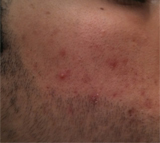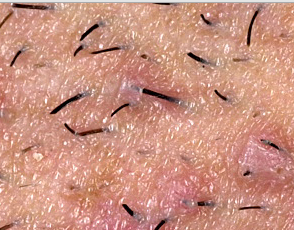How to get Rid of Ingrown Hair Scars
Body hairs sometimes become ingrown and can often leave scars.
Where hair grows which is anywhere in the body ingrown hair can occur, though they are more likely on places where you regularly remove hair. Men commonly experience ingrown hairs on the face, back, chest, legs and arms. Women tend to have ingrown hairs on the bikini area, legs and armpits. If you pick or squeeze ingrown hairs, you may damage the skin permanently. Scars from ingrown hairs are very common. Thankfully, there are many things you can do to reduce the appearance of ingrown hair scars.
Medical Treatments
 Visit a dermatologist. A doctor can prescribe you stronger bleaching or fading creams. Ask your doctor about Retin-A creams. These topical treatments encourage cell regeneration, meaning that you’ll have a fresher, more even skin tone with regular use.
Visit a dermatologist. A doctor can prescribe you stronger bleaching or fading creams. Ask your doctor about Retin-A creams. These topical treatments encourage cell regeneration, meaning that you’ll have a fresher, more even skin tone with regular use.
Get laser treatment on the ingrown hair scars. Laser light will target the hyperpigmentation in the scars, thereby lightening the area. In addition, laser treatments encourage collagen production so your skin will look firmer and more even. Laser treatments can be quite expensive, and you’ll generally need multiple sessions to achieve satisfactory results.
Talk to your dermatologist about chemical peels to lighten the ingrown hair scars. Depending on the severity of scars, you can opt for light, medium or deep chemical peels. Your skin will be burned by the chemicals, but after it heals, younger skin will be revealed. If you opt for a series of peels, you’ll generally have better results.
Consider microdermabrasion on the scarred area. The top layers of your skin will be buffed away by a mini sandblaster-type device. The skin below will be younger and less damaged so the scars will not be as apparent.
Personal Hygiene
Exfoliate the area, by using a body scrub and loofah. Exfoliation removes dead skin cells, thereby encouraging new skin cell production. Less damaged skin cells will be apparent sooner when you exfoliate regularly.
Wear sunscreen on the scarred area. The sun will often worsen the appearance of ingrown hair scars. In order to fade the scars more quickly, keep the area protected from the sun’s damaging rays. Choose a full-protection sunscreen with a high SPF rating.
Some people report having results by rubbing cocoa butter on the ingrown hair scars. Cocoa butter has been shown to fade scars and encourage healthy skin.
Ingrown hair scars usually have a darker pigmentation than the surrounding skin. When applying bleaching cream to the scars it will lighten the scars, helping then blend in with the rest of your skin. You’ll need to apply most over-the-counter bleaching creams twice a day for several weeks before you see results.
 Just like what is seen with pimples, when one has an ingrown hair, it produces a small raised red bump. That bump will be itchy and many times might be sore to the touch. Treatment for ingrown hair may not be necessary at all times because ingrown hair sometimes tends to go away on its own. However, if the ingrown hair does not go away, it is best to treat it as it may leave a dark spot or scar on your skin. If an ingrown hair becomes infected, a doctor’s visit is necessary where they can safely use a needle to release the hair.
Just like what is seen with pimples, when one has an ingrown hair, it produces a small raised red bump. That bump will be itchy and many times might be sore to the touch. Treatment for ingrown hair may not be necessary at all times because ingrown hair sometimes tends to go away on its own. However, if the ingrown hair does not go away, it is best to treat it as it may leave a dark spot or scar on your skin. If an ingrown hair becomes infected, a doctor’s visit is necessary where they can safely use a needle to release the hair. 
